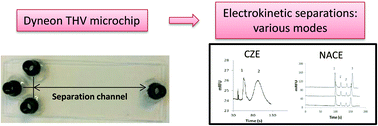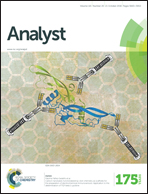Dyneon THV, a fluorinated thermoplastic as a novel material for microchip capillary electrophoresis
Abstract
In this work, we have investigated Dyneon THV, a fluorinated material, as a new material to afford electrokinetic separations in microfluidic devices. To overcome protein adsorption, two poly(ethylene oxide) (PEO)-based coatings have been investigated: Pluronic F127 and PEO stearate 40. The best results were obtained with the PEO stearate 40 coating which allowed decreasing the surface contact angle from 91 ± 3 to 76° ± 3. With this surface treatment, a 66% reduction of the electroosmotic mobility at pH 8.0 and a marked suppression of protein adsorption were observed compared to a native Dyneon THV microchip. Finally, a separation of fluorescently labeled proteins (bovine serum albumin and trypsin inhibitor), well-known for their strong tendency to adsorb on hydrophobic surfaces, was successfully achieved in an HEPES buffer with a PEO stearate 40 treated microchip by capillary zone electrophoresis. Furthermore, we demonstrated the possibility to perform non-aqueous capillary electrophoresis analysis of hydrophobic dyes using various solvents in untreated microchips. The overall results demonstrated not only the suitability of the Dyneon THV microchip for electrokinetic separations, but also its versatility allowing different separation modes to be implemented with the same microchip material.


 Please wait while we load your content...
Please wait while we load your content...